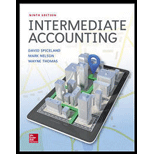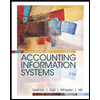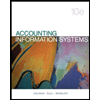1 Environment And Theoretical Structure Of Financial Accounting 2 Review Of The Accounting Process 3 The Balance Sheet And Financial Disclosures 4 The Income Statement, Comprehensive Income, And The Statement Of Cash Flows 5 Revenue Recognition 6 Time Value Of Money Concepts 7 Cash And Receivables 8 Inventories: Measurement 9 Inventories: Additional Issues 10 Property, Plant, And Equipment And Intangible Assets: Acquisition 11 Property, Plant, And Equipment And Intangible Assets: Utilization And Disposition 12 Investments 13 Current Liabilities And Contingencies 14 Bonds And Long-Term Notes 15 Leases 16 Accounting For Income Taxes 17 Pension And Other Postretirement Benefit Plans 18 Shareholders' Equity 19 Share-Based Compensation And Earnings Per Share 20 Accounting Changes And Error Corrections 21 Statement Of Cash Flows Revisited A Appendix: Derivatives expand_more
Chapter Questions expand_more
Problem 5.1Q: What are the five key steps a company follows to apply the core revenue recognition principle? Problem 5.2Q: What indicators suggest that a performance obligation has been satisfied at a single point in time? Problem 5.3Q: What criteria determine whether a company can recognize revenue over time? Problem 5.4Q: We recognize service revenue either at one point in time or over a period of time. Explain the... Problem 5.5Q: What characteristics make a good or service a performance obligation? Problem 5.6Q Problem 5.7Q: What must a contract include for the contract to exist for purposes of revenue recognition? Problem 5.8Q: How might the definition of probable affect determining whether a contract exists under IFRS as... Problem 5.9Q: When a contract includes an option to buy additional goods or services, when does that option give... Problem 5.10Q Problem 5.11Q Problem 5.12Q: Is a customers right to return merchandise a performance obligation of the seller? How should... Problem 5.13Q Problem 5.14Q: Under what circumstances should sellers consider the time value of money when recognizing revenue? Problem 5.15Q: When should a seller view a payment to its customer as a refund of part of the price paid by the... Problem 5.16Q: What are three methods for estimating stand-alone selling prices of goods and services that normally... Problem 5.17Q: When is revenue recognized with respect to licenses? Problem 5.18Q: In a franchise arrangement, what are a franchisors typical performance obligations? Problem 5.19Q: When does a company typically recognize revenue for a bill-and-hold sale? Problem 5.20Q Problem 5.21Q Problem 5.22Q Problem 5.23Q: Must bad debt expense be reported on its own line on the income statement? If not, how should it be... Problem 5.24Q: Explain the difference between contract assets, contract liabilities, and accounts receivable. Problem 5.25Q: Explain how to account for revenue on a long-term contract over time as opposed to at a point in... Problem 5.26Q Problem 5.27Q Problem 5.28Q: What are the two general criteria that must be satisfied before a company can recognize revenue? Problem 5.29Q: Explain why, in most cases, a seller recognizes revenue when it delivers its product rather than... Problem 5.30Q: Revenue recognition for most installment sales occurs at the point of delivery of the product or... Problem 5.31Q Problem 5.32Q: How does a company report deferred gross profit resulting from the use of the instalment sales... Problem 5.33Q Problem 5.34Q: Briefly describe the guidelines for recognizing revenue from the sale of software and other... Problem 5.35Q Problem 5.36Q: Briefly describe the guidelines provided by GAAP for the recognition of revenue by a franchisor for... Problem 5.1BE: Revenue recognition at a point in time LO52 On July 1, 2018, Apache Company, a real estate... Problem 5.2BE: Timing of revenue recognition LO53 Estate Construction is constructing a building for CyberB, an... Problem 5.3BE Problem 5.4BE: Allocating the transaction price LO54 Sarjit Systems sold software to a customer for 80,000. As... Problem 5.5BE: Existence of a contract LO5-5 Tulane Tires wrote a contract for a 100,000 sale to the new Garden... Problem 5.6BE Problem 5.7BE Problem 5.8BE: Performance obligations; warranties LO55 Vroom Vacuums sells the Tornado vacuum cleaner. Each... Problem 5.9BE Problem 5.10BE Problem 5.11BE: Performance obligations; construction LO55 Precision Equipment, Inc., specializes in designing and... Problem 5.12BE Problem 5.13BE Problem 5.14BE: Variable consideration LO56 Leo Consulting enters into a contract with Highgate University to... Problem 5.15BE: Variable consideration LO56 In January 2018, Continental Fund Services, Inc., enters into a... Problem 5.16BE Problem 5.17BE Problem 5.18BE: Payment s by the seller to the customer LO56 Lewis Co. sold merchandise to AdCo for 60,000 and... Problem 5.19BE: Estimating stand-alone selling prices: adjusted market assessment approach LO56 OHara Associates... Problem 5.20BE: Estimating stand-alone selling prices: expected cost plus margin approach LO56 OHara Associates... Problem 5.21BE: Estimating stand-alone selling prices; residual approach LO56 OHara Associates sells golf clubs,... Problem 5.22BE: Timing of revenue recognition; licenses LO57 Saar Associates sells two licenses to Kim Company on... Problem 5.23BE Problem 5.24BE Problem 5.25BE: Timing of revenue recognition; franchises LO57 TopChop sells hairstyling franchises. TopChop... Problem 5.26BE: Timing of revenue recognition; bill-and-hold LO57 Dowell Fishing Supply, Inc., sold 50,000 of... Problem 5.27BE Problem 5.28BE Problem 5.29BE: Contract assets and contract liabilities LO58 Holt Industries received a 2,000 prepayment from the... Problem 5.30BE Problem 5.31BE: Long-term contract; revenue recognition over time; profit recognition LO59 A construction company... Problem 5.32BE Problem 5.33BE: Long-term contract; revenue recognition upon completion LO59 Refer to the situation described in BE... Problem 5.34BE: Long-term contract; revenue recognition; loss on entire project LO59 Franklin Construction entered... Problem 5.35BE: Installment sales method On July 1, 2018, Apache Company sold a parcel of undeveloped land to a... Problem 5.36BE Problem 5.37BE: Cost recovery method Refer to the situation described in BE 535. How much gross profit will Apache... Problem 5.38BE Problem 5.39BE Problem 5.40BE: Revenue recognition; software contracts under IFRS Refer to the situation described in BE 539. How... Problem 5.41BE Problem 5.1E Problem 5.2E Problem 5.3E: Allocating transaction price LO54 Video Planet (VP) sells a big screen TV package consisting of a... Problem 5.4E Problem 5.5E Problem 5.6E Problem 5.7E Problem 5.8E Problem 5.9E Problem 5.10E: Variable considerationmost likely amount; change in estimate LO53, LO56 Rocky Guide Service... Problem 5.11E: Variable considerationexpected value; change in estimate LO53, LO56 Assume the same facts as in E... Problem 5.12E Problem 5.13E: Approaches for estimating stand-alone selling prices LO56 (This exercise is a variation of E 53.)... Problem 5.14E: FASB codification research LO56, LO57 Access the FASB Accounting Standards Codification at the FASB... Problem 5.15E: Franchises; residual method LO56, LO57 Monitor Muffler sells franchise arrangements throughout the... Problem 5.16E: FASB codification research LO58 Access the FASB Accounting Standards Codification at the FASB... Problem 5.17E: Long-term contract; revenue recognition over time and at a point in time LO59 Assume Nortel... Problem 5.18E: Long-term contract; revenue recognition over time vs. upon project completion LO59 On June 15,... Problem 5.19E: Long-term contract; revenue recognition over time; loss projected on entire project LO59 On... Problem 5.20E: Long-term contract; revenue recognition upon project completion; loss projected on entire project ... Problem 5.21E: Income (loss) recognition; Long-term contract; revenue recognition over time vs. upon project... Problem 5.22E: Long-term contract; revenue recognition over time; solve for unknowns LO59 In 2018, Long... Problem 5.23E: Installment sales method Charter Corporation, which began business in 2018, appropriately uses the... Problem 5.24E: Installment sales method; journal entries [This is a variation of E 523 focusing on journal... Problem 5.25E: Installment sales; alternative recognition methods On July 1, 2018, the Foster Company sold... Problem 5.26E: Journal entries; point of delivery, installment sales, and cost recovery methods [This is a... Problem 5.27E Problem 5.28E Problem 5.29E Problem 5.30E Problem 5.31E Problem 5.32E Problem 5.33E Problem 5.34E Problem 5.35E Problem 5.1P Problem 5.2P Problem 5.3P Problem 5.4P Problem 5.5P Problem 5.6P: Variable consideration; change of estimate LO53, LO56 Since 1970, Super Rise, Inc., has provided... Problem 5.7P Problem 5.8P Problem 5.9P Problem 5.10P: Long-term contract; revenue recognition over time LO58, LO59 In 2018, the Westgate Construction... Problem 5.11P: Long-term contract; revenue recognition upon completion LO59 [This is a variation of P 510 modified... Problem 5.12P: Long-term contract; revenue recognized over time; loss projected on entire project LO59 Curtiss... Problem 5.13P: Long-term contract; revenue recognition over time vs. upon project completion LO59 Citation... Problem 5.14P: Income statement presentation; installment sales method (Chapters 4 and 5) Reagan Corporation... Problem 5.15P Problem 5.16P: Installment sales; alternative recognition methods On August 31, 2018, the Silva Company sold... Problem 5.17P: Installment sales and cost recovery methods Mulcahey Builders (MB) remodels office buildings in... Problem 5.18P Problem 5.19P: Franchise sales; installment sales method Olive Branch Restaurant Corporation sells franchises... Problem 5.1BYP Problem 5.2BYP: Judgment Case 52 Satisfaction of performance obligations LO52 Assume McDonalds enters into a... Problem 5.3BYP: Judgment Case 53 Satisfaction of performance obligations LO52 Cutler Education Corporation... Problem 5.4BYP Problem 5.5BYP Problem 5.6BYP Problem 5.8BYP Problem 5.9BYP Problem 5.10BYP Problem 5.11BYP Problem 5.12BYP Problem 5.13BYP Problem 5.14BYP Problem 5.15BYP Problem 5.16BYP Problem 5.19BYP Problem 1CCTC format_list_bulleted


 Accounting Information SystemsFinanceISBN:9781337552127Author:Ulric J. Gelinas, Richard B. Dull, Patrick Wheeler, Mary Callahan HillPublisher:Cengage Learning
Accounting Information SystemsFinanceISBN:9781337552127Author:Ulric J. Gelinas, Richard B. Dull, Patrick Wheeler, Mary Callahan HillPublisher:Cengage Learning Pkg Acc Infor Systems MS VISIO CDFinanceISBN:9781133935940Author:Ulric J. GelinasPublisher:CENGAGE L
Pkg Acc Infor Systems MS VISIO CDFinanceISBN:9781133935940Author:Ulric J. GelinasPublisher:CENGAGE L Auditing: A Risk Based-Approach (MindTap Course L...AccountingISBN:9781337619455Author:Karla M Johnstone, Audrey A. Gramling, Larry E. RittenbergPublisher:Cengage Learning
Auditing: A Risk Based-Approach (MindTap Course L...AccountingISBN:9781337619455Author:Karla M Johnstone, Audrey A. Gramling, Larry E. RittenbergPublisher:Cengage Learning Intermediate Accounting: Reporting And AnalysisAccountingISBN:9781337788281Author:James M. Wahlen, Jefferson P. Jones, Donald PagachPublisher:Cengage Learning
Intermediate Accounting: Reporting And AnalysisAccountingISBN:9781337788281Author:James M. Wahlen, Jefferson P. Jones, Donald PagachPublisher:Cengage Learning Fundamentals Of Financial Management, Concise Edi...FinanceISBN:9781337902571Author:Eugene F. Brigham, Joel F. HoustonPublisher:Cengage Learning
Fundamentals Of Financial Management, Concise Edi...FinanceISBN:9781337902571Author:Eugene F. Brigham, Joel F. HoustonPublisher:Cengage Learning




